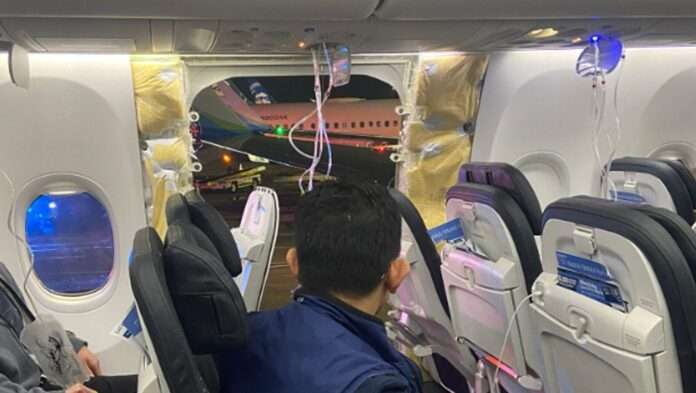Friday’s midair emergency landing of an Alaska Airlines Boeing 737 Max 9 jet has renewed concerns about the aircraft’s safety. Shortly after takeoff from Portland, the plane lost a large section of its metal fuselage, leaving a gaping hole in the side of the aircraft. The crew made an immediate turn back to the airport, reporting a pressurization issue to air traffic control. The plane landed safely within 15 minutes, though one flight attendant sustained minor injuries. All 171 passengers counted themselves extremely lucky to have avoided potential disaster.
Photos of the damage show the plane missing a whole panel towards the rear of the plane rather than a small fracture. The decompression blew a chunk of metal off strong enough to cause injuries. Passengers described hearing a loud explosion followed by extreme winds and seeing the night sky through the opening as oxygen masks deployed. It certainly made for a terrifying ordeal, especially given the Max’s problematic history with two previous crashes.
This alarming incident comes five years after the entire Boeing 737 Max fleet was grounded worldwide following accidents in 2018 and 2019 that killed 346 people. Investigations found faults in the flight control system led to both crashes – Lion Air Flight 610 nose-dived into the Java Sea after takeoff from Jakarta and Ethiopian Airlines Flight 302 rapidly descended shortly after leaving Addis Ababa. The system malfunctioned based on erroneous data from a single sensor. Boeing fixed the software and made other modifications after 20 months of being out of service. Regulators approved the plane to resume flying in late 2020.
However, controversy and concerns around the Max persist years later. Boeing still faces ongoing lawsuits and settlements related to the crashes, including $2.5 billion paid to the Justice Department last year. Relatives of victims continue advocating for more accountability and reforms. While statistically air travel remains extremely safe, the accidents shattered public confidence in Boeing and regulatory oversight. Any new potential issue with the Max generates major attention because of this troubled history.
That’s certainly been the case with this latest incident and the fleetwide grounding of Max 9s that followed. The FAA ordered over 170 of the newer Max 9 models taken out of service for immediate inspection after the Alaska emergency landing. Cracks or damage that compromise the structural integrity of the fuselage could lead to explosive decompression at high altitudes. Alaska and United Airlines confirmed they are complying, which affects about one-fifth of Max 9s currently in service.
The root cause is still under investigation, but early analysis points to a possible manufacturing defect according to aviation experts. Unlike metal fatigue from age which manifests in predictable places, this missing panel was towards the rear of the plane on the side. Also the aircraft itself was brand new – the plane in question entered service just this past November after being certified by the FAA. It had flown only 145 times before last Friday’s incident, giving little opportunity for wear and tear issues to arise.
While examination of the damage continues, the location and nature likely rules out maintenance errors as well. The missing panel was not along typical access points where openings are made for inspections and repairs. The section lost also had an intact window frame – if opened for maintenance there would be fastener holes visible. This supports the theory of a production problem rather than technician failure. Detailed analysis should provide more definitive answers soon.
Boeing asserts that safety remains their priority and has pledged full cooperation with regulators’ inquiries into the event. However it nonetheless further hurts public confidence and the airplane manufacturer’s reputation. It raises unsettling questions about the true airworthiness of a model that supposedly fixed underlying problems. Relatively minor issues acquire outsized significance because of the Max’s history. Each new technical concern dredges up the terrifying disasters from a few years ago that were supposed to be prevented from recurring.
Airlines also face a delicate balancing act responding to this event. They sought to reassure anxious customers and crew without indulging overreactions either. Alaska proactively grounded its Max 9 fleet for inspection immediately after the emergency landing. They expect to return most to service shortly, though at the cost of disrupting travel plans for thousands this past weekend. The situation highlights the ongoing delicacy required navigating the Max’s stigma. Even relatively minor problems elicit an exceptional response compared to other plane models, reflecting the scars left by its past disasters.
Industry groups argue that hundreds of upgrades and design changes have made the Max among the safest planes flying today. They contend problems get magnified unfairly compared to other aircraft models that routinely suffer minor technical issues without generating such intense scrutiny. But the concerns come naturally given the shadows cast by the tragic crashes still fresh in recent memory. It seems only the passage of substantial time rebuilding confidence rather than specific fixes will heal the Max’s reputation.
Boeing and airlines continue working to rehabilitate the Max’s image and reassure both passengers and crews about its airworthiness. But Friday’s incident demonstrates how any problem immediately raises the terrifying prospect of a repeat disaster in the public’s mind. Progress remains agonizingly slow trying to restore faith after such devastating accidents, especially when new reports like this keep prominent focus on the Max. Each one prompts revisiting the painful crashes and reopen doubts about the aircraft’s safety.
At this point even relatively minor technical issues acquire huge significance that sets back efforts to move forward. Boeing and aviation regulators still have hard work ahead trying to convince a skeptical public that the Max can indeed fly safely again. It seems past disasters have left a cloud that will hang over this model for a long time. Their shadow remains indelible, with any new potential problem making frightening headlines. The Max may yet win back confidence, but it faces persistent headwinds shedding a reputation for catastrophe.





















